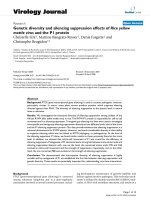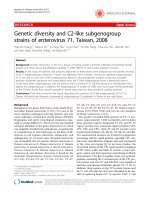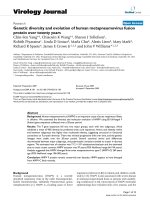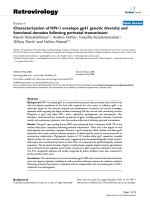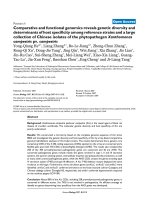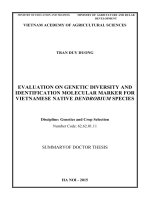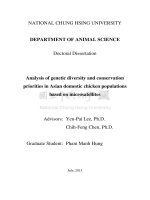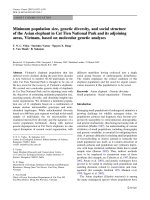Evaluation of genetic diversity and presence of late blight (phytophthora infestans) resistance genes in some promising hybrid potato lines by molecular markers (khóa luận tốt nghiệp)
Bạn đang xem bản rút gọn của tài liệu. Xem và tải ngay bản đầy đủ của tài liệu tại đây (2.2 MB, 61 trang )
VIETNAM NATIONAL UNIVERSITY OF AGRICULTURE
FACULTY OF BIOTECHNOLOGY
------- -------
GRADUATION THESIS
PROJECT:
EVALUATION OF GENETIC DIVERSITY AND
PRESENCE OF LATE BLIGHT (PHYTOPHTHORA
INFESTANS) RESISTANCE GENES IN SOME
PROMISING HYBRID POTATO LINES BY
MOLECULAR MARKERS
HA NOI - 2022
VIETNAM NATIONAL UNIVERSITY OF AGRICULTURE
FACULTY OF BIOTECHNOLOGY
------- -------
GRADUATION THESIS
PROJECT:
EVALUATION OF GENETIC DIVERSITY AND
PRESENCE OF LATE BLIGHT (PHYTOPHTHORA
INFESTANS) RESISTANCE GENES IN SOME
PROMISING HYBRID POTATO LINES BY
MOLECULAR MARKERS
Student Name
: Le Van Ngoc
Class
: K63CNSHE
Student Code
: 637424
Instructor
: Nguyen Xuan Truong, Ph.D
HA NOI – 2022
COMMITMENT
I assure that the whole research process was performed by myself under the
scientific guidance of Ph.D. Nguyen Xuan Truong.
I assure that all research contents, results, and information in my thesis is
completely honest and unpublished.
Hanoi, December 05th 2022
Student
Le Van Ngoc
i
ACKNOWLEDGEMENTS
In order to complete the graduation thesis, besides my own efforts, I have
received a lot of enthusiastic support from teachers, friends and relatives.
First, I would like to start by expressing my sincere gratitude to Nguyen Xuan
Truong, a PhD. supervisor for helping me finish my thesis with their guidance and
expertise. Additionally, their advice was helpful to me as I was preparing this thesis.
I want to thank PhD. Dinh Truong Son and all my teachers in the Faculty of
Biotechnology, especially the Department of Plant Biotechnology. They provided
useful scientific knowledge as well as technique for me and where supporting
equipment and finances for my thesis. One of the most crucial elements that will
enable me to successfully complete my thesis is this.
I appreciate the passionate assistance from the Institute of Biotechnology and
everyone who works there so that I can have the finest thesis.
I thank my lab-mate for his meaningful contribution. I will appreciate the time
when we were working together.
Last but not least, I would specifically like to thank my family, especially my
parents who have loved me, cared for me, trusted me and given me the best study
condition.
Hanoi, December 05th 2022
Student
Le Van Ngoc
ii
CONTENTS
COMMITMENT ............................................................................................................. i
ACKNOWLEDGEMENTS ........................................................................................... ii
CONTENTS .................................................................................................................. iii
ABBREVIATION ...........................................................................................................v
LIST OF TABLES ........................................................................................................ vi
PART 1. INTRODUCTION ............................................................................................1
1.1. Preface ......................................................................................................................1
1.2. Purposes and requirements .......................................................................................1
1.2.1. Purposes .................................................................................................................1
1.2.2. Requirements .........................................................................................................2
PART 2. LITERATURE OVERVIEW ...........................................................................3
2.1. Introduction of potato ...............................................................................................3
2.1.1. Origin .....................................................................................................................3
2.1.2. Genetics .................................................................................................................3
2.1.3. Botanical characteristics ........................................................................................5
2.1.4. Nutrient content in potatoes...................................................................................7
2.1.5. Potato production in the world ..............................................................................7
2.1.6. Potato production in Vietnam ................................................................................8
2.2. Phytophthora infestans in potato ..............................................................................9
2.2.1. Discovery history...................................................................................................9
2.2.2. Distribution range ................................................................................................10
2.2.3. Symptoms ............................................................................................................10
2.2.4. The cause to the illness ........................................................................................11
2.3. Molecular markers and applications of RAPD and ISSR markers in genetic
diversity analysis ...........................................................................................................13
2.3.1. Definition .............................................................................................................13
2.3.2. RAPD molecular marker .....................................................................................13
2.3.3. ISSR molecular marker .......................................................................................14
iii
2.4 Researches on potato (Solanum tuberosum L.) using RAPD and ISSR molecular
markers ..........................................................................................................................15
PART 3. MATERIALS AND METHODS ...................................................................17
3.1. Materials .................................................................................................................17
3.2. Time and Place of the Study ...................................................................................17
3.3. Research equipment................................................................................................17
3.4. Chemical substances ...............................................................................................18
3.5. Methods ..................................................................................................................20
3.5.1. DNA extraction ...................................................................................................20
3.5.2. PCR reaction ........................................................................................................21
3.5.3. Gel electrophoresis ..............................................................................................22
3.5.4. Data analysis ........................................................................................................23
PART 4. RESULTS AND DISCUSSION ....................................................................24
4.1. DNA extraction ......................................................................................................24
4.2. Genetic diversity analysis of 28 potato lines using RAPD molecular ..................28
4.3. Genetic diversity analysis using ISSR molecular markers .....................................33
4.4. Genetic diversity analysis combined RAPD and ISSR molecular markers ...........37
PART 5. CONCLUSION AND SUGGESTION ..........................................................42
5.1. Conclusion ..............................................................................................................42
5.2. Suggestion ..............................................................................................................42
REFERENCES ..............................................................................................................43
APPENDIX ...................................................................................................................44
iv
ABBREVIATION
CTAB
Cetyl trimethylammonium bromide
DNA
Deoxyribonucleic Acid
dNTPs
Deoxynucleotide Solution Mix
EDTA
Etylen Diamine Tetra Acetic Acid
ISSR
Inter-Simple Sequence Repeats
RAPD
Random Amplified Phlymorphic DNA
PCR
Polymerase chain reaction
TAE
Tris base, acetic acid and EDTA
PVPP
Poly Vinyl Poly Pyrrolidone
v
LIST OF TABLES
Table 2.1 Potato yield of the top 5 countries in the world in 2012 and 2013 .................8
Table 3.1: 48 potato lines and three commercial varieties used for the study ..............17
Table 3.2 List of chemical substances used in research ................................................18
Table 3.3 List of RAPD primers used in research .........................................................18
Table 3.4 List of ISSR primers used in research ...........................................................18
Table 3.5 List of molecular markers associated with late blight resistance genes in
potato ..................................................................................................................19
Table 3.6 Components of each PCR reaction ................................................................22
Table 3.7. Thermal cycler of PCR .................................................................................22
Table 4.1. Concentration and quality of DNA isolated from 48 potato line and varieties
............................................................................................................................24
Table 4.2 The present of resistant gene in studied potato lines, symbol “+” for presence
the gene, empty cells represent no detection. .....................................................26
Table 4.3 Polymorphism of 28 lines of potato revealed by RAPD markers .................28
Table 4.4 Matrix of genetic similarity among 28 accessions of potato revealed by
RAPD markers calculated by similarity coefficient of Sokal-Michener 30Error!
Bookmark not defined.
Table 4.5. Polymorphism of 28 potato lines accessions revealed by ISSR markers.....33
Table 4.6 Matrix of genetic similarity among 28 potato accessions revealed by ISSR
markers calculated by similarity coefficient of Sokal-Michener .......................35
Table 4.7 Matrix of genetic similarity among 28 potato accessions revealed by
combined RAPD and ISSR markers calculated by similarity coefficient of
Sokal-Michener ...................................................................................................38
Table 4.8 Matrix comparisons of Mantel test / Two-tailed test between markers ........41
vi
LIST OF FIGURES
Figure 2.1. Botanical characteristics of potato ................................................................6
Figure 4.1. Results of electrophoresis product with primer APG-05 ............................27
Figure 4. 2. UPGMA cluster analysis of 28 accessions of potato lines with a similarity
coefficient of RAPD marker .............................................................................32
Figure 4. 3. Principal component analysis (PCA) of 28 potato accessions based on
RAPD marker ....................................................................................................33
Figure 4. 4. UPGMA cluster analysis of 28 potato accessions with a similarity
coefficient of ISSR marker................................................................................36
Figure 4.5. PCA analysis of 28 potato accessions based on ISSR markers ..................37
Figure 4.6. UPGMA cluster analysis of 28 potato accessions with a similarity
coefficient combined RAPD and ISSR marker .................................................39
Figure 4. 7. Principal component analysis (PCA) of 28 potato accessions based on
pooled RAPD and ISSR marker ........................................................................40
vii
PART 1. INTRODUCTION
1.1. Preface
Potato (Solanum tuberosum L.) is a short-term crop that plays a significant role
in human food crops. It is a member of the Solanaceae family and is native to Bolivia
and Peru’s Andes mountains. In terms of food production, potatoes are currently the
fourth most widely planted crop after rice, wheat and maize. They are the most widely
grown tuber in the world. They can adapt to a variety of environment situations, are
simple to grow and produce a speedy harvest (International Year of the Potato 2008;
Jeff Chapman et al. 2011). The productivity and quality of tubers are, however, greatly
impacted by a number of illnesses that are frequently transmitted to potatoes. Diseases
on potatoes are very diverse, rich in composition and cause of disease such as late
blight, yellow wilt, viral leaf curl… Late blight caused by Phytophthora infestans is
considered the most harmful in the world, resulting approximately 16% output losses
globally (Haverkort A et al. 2009).
With the strong development of molecular biology, the breeding technology of
molecular markers ensure accuracy, and be able to gather many targeted genes into
one variety. Traditional breeding methods are difficult or impossible to do.
To create a new potato variety, the first thing is to have a source of resistance
genes and molecular markers associated with those resistance genes, then evaluate and
determine the resistance to late blight of the variety to use for future breeding.
Therefore, I conduct this work: “Evaluation of genetic diversity and presence of late
blight (Phytophthora infestans) resistance genes in some promising hybrid potato lines
by molecular markers”.
1.2. Purposes and requirements
1.2.1. Purposes
- Finding promising potato lines containing late blight resistance genes.
- Besides, Analysis the genetic diversity and relationships between 28 potato
samples by RAPD and ISSR molecular markers.
1
1.2.2. Requirements
- Using DNA molecular markers to detect resistance genes in potato seed
samples
- Evaluation of the genetic diversity of the potato seed samples
2
PART 2. LITERATURE OVERVIEW
2.1. Introduction of potato
2.1.1. Origin
Potato (Solanumtuberosum L.) is indigenous to the highlands of South
America’s Andes Mountains, where it grows at elevations of 2000-5000 meters. When
the Spaniards first arrived in the Magdalena valley (South America), they found
potatoes, beans and grain there along with the Indians who had fled. Due to the vibrant
blossoms at the time, people nicknamed potatoes truffles (Salaman, 1949).
Numerous historical locations have been uncovered by scientists as evidence
that the potato plant existed as far back as 500 BC. Farmers cultivated hundreds of
different varieties of potatoes throughout the mountains of what are now Bolivia,
Chile, Colombia, Ecuador, and Peru during the Spanish conquest of the Americas in
the 16th century (Horton, 1987). The original potato types are still grown by the
Indians of the Titicaca region today (Ducreux, 1989).
A Frenchman who serves as the head of the Hanoi Botanical Garden is
responsible for bringing potatoes to our nation. We called this plant "potato" because
the French introduced it to our nation and made its cultivation popular (Vu Huong
Van, 2007). At the moment, potato cultivation is concentrated in the Red River Delta,
Sapa, and Da Lat, all of which have cold and temperate climates... (Do Kim Chung,
2003).
2.1.2. Genetics
Worldwide, there are around 5,000 different potato kinds. The Andes alone
contain 3,000 of them, mostly in Peru, Bolivia, Ecuador, Chile, and Colombia.
Depending on the taxonomic school, they belong to either eight or nine species. There
are more than 200 wild species and subspecies in addition to the 5,000 cultivated
cultivars, many of which can interbreed. Numerous crossbreeding attempts have been
made to add pest and disease resistances from the gene pool of wild species to the gene
pool of domesticated potato species.
3
Modern forms of Solanum tuberosum, a tetraploid species with 48
chromosomes, are the most frequently grown plant in the world. The four other species
are S. stenotomum, S. phureja, S. goniocalyx, and S. ajanhuiri, all of which are diploid
(have 24 chromosomes). The two species that are triploid (with 36 chromosomes each)
are S. chaucha and S. juzepczukii. One cultivable pentaploid species, S. curtilobum,
has 60 chromosomes. Solanum tuberosum has two main subspecies: andigena, often
known as Andean, and tuberosum, also known as Chilean. The Chilean potato, a
native of the Chiloé Archipelago, is adapted to the long-day conditions common in the
higher latitude region of southern Chile, unlike the Andean potato, which is adapted to
the short-day conditions prevalent in the mountainous equatorial and tropical regions
where it originated.
There are 4,870 different varieties of potato germplasm available at the
International Potato Center in Lima, Peru, the majority of which are conventional
landrace cultivars. The potato genome is a medium-sized plant genome with 12
chromosomes and 860 million base pairs, according to the 2009 announcement by the
international Potato Genome Sequencing Consortium. A subspecies that formerly
flourished in the lowlands of south-central Chile is directly ancestors of more than 99
percent of the potato types farmed today. But genetic analysis of the several cultivars
and wild species confirms that all potato subspecies originate from a single origin in
the region of modern-day southern Peru and extreme Northwestern Bolivia (from a
species in the Solanum brevicaule complex).
Although at least one wild potato species, Solanum fendleri, naturally ranges
from Peru into Texas, where it is used in breeding for resistance to a nematode species
that attacks cultivated potatoes, the majority of modern potatoes grown in North
America arrived through European settlement and not independently from the sources
in South America. The hexaploid Solanum demissum, a source of resistance to the
deadly late blight disease, is one of the significant wild species that have been heavily
employed in modern breeding. Mexico is a secondary center of genetic variety for
potatoes. The potato has been genetically modified to withstand potato blight using
Solanum bulbocastanum, a different cousin that is endemic to this area.
4
2.1.3. Botanical characteristics
When potatoes are produced from seed tubers, only bunch roots form; when
potatoes are grown from seeds, tap roots form; from tap roots, numerous auxiliary
roots form. Although the roots of the underground stems, commonly referred to as
tubers, are likewise capable of growing, they are shorter and less branching. The root
system has roots that extend up to 1.5 to 2 meters below the surface of arable soil,
where it is primarily dispersed (Ta Thu Cuc, 2007).
Potato stems typically grow straight, occasionally zigzag, have three to four
sides, and range in height from 40 to 70 cm to 1 to 1.2 meters. The amount of time
needed to maintain a plant's height might vary depending on the species. Depending
on the cultivar, the stem is often green, light green, dark green, or occasionally pink or
purple in color.
The size of the leaf plate, the compound leaves' bifurcation, the number of pairs
growing symmetrically across the axis, and the size of the odd leaf at the top of the
plant, known as the apical leaflet, all depend on the variety, season, and care
conditions of the plant. Green, dark green, or light green are the most common shades
of leaf color.
Potato seeds are very small, weighing 1000 seeds only about 0.7g to 1g. Oval in
shape, seeds contain an embryo, an endosperm, and an outer shell. The U-shaped
potato embryo has two cotyledons and cotyledons inside. Stems develop underground,
in dim lighting. The potato tuber might be square, rectangular, elliptical, or any
combination of these shapes. Depending on the variety, the tuber's color can vary.
Because the potato tuber is made up of white, off-white, yellow, or pale yellow skins,
among other colors, it is also known as the potato tuber or underground stem. Potatoes
grow from the tuber's growth point, a sterile reproductive organ. characteristics of
potatoes Depending on the kind, sprouts can be either white or purple when exposed to
blue light.
5
Figure 2.1. Botanical characteristics of potato
6
2.1.4. Nutrient content in potatoes
Potato is both a food crop and a crop with great nutritional value; only eggs
have a higher nutritious content than potatoes (Leviel, 1986). Using 100g of potatoes
can meet a person's daily requirements for at least 8% of their protein, 3% of their
energy, 10% of their iron, 10% of their vitamin B1, and 20 to 50% of their vitamin C
(Beukemaetal., 1990; Horton, 1987). Regarding crops grown in tropical and
subtropical regions, VanderZaag (1976) stated that the potato plan is more profitable
than any other crop because it provides the highest energy and protein yied. Vietnam
Red Book (2007) with the endangered classification VU - will be endangered.
It is said that, potatoes serve as both food and medicine. According to study,
potatoes have a lot of antioxidants that can slow down the aging process, prevent
cancer, and treat various other diseases, according to Professor Venket Rao of the
Department of Nutrition at the University of Toronto Medical School in Canada.
Regular consumption of potatoes has been demonstrated to lower the risk of prostate
cancer. The high levels of stomach acid can be neutralized by drinking fresh potato
juice, which also helps to improve digestion and treat anorexia nervosa. As a result,
the Russian people have had experience utilizing potato juice to relieve stomach pain
since ancient times.
2.1.5. Potato production in the world
The world's potato production has changed significantly. The majority of
potatoes were cultivated and eaten as of the early 1990s in Europe, North America,
and the former Soviet Union. Since then, Asia, Africa, and Latin America have seen a
considerable rise in both supply and demand for potatoes, with production rising from
less than 30 million tons in early 1960 to more than 165 million tons in 2007.
Major potato-producing regions include Asia and Europe, which together
accounted for more than 80% of global production in 2007. While more than 20% of
the world's potato plantings are in Africa and Latin America. Averaging 40 tons per
ha, North America is the world's top producer of potatoes. Nearly half of the world's
potatoes are consumed in Asia, but due to its enormous population, per capita
consumption was just 24 kg in 2005, making Europe the top consumer. Although
consumption per person is lowest in Africa and Latin America, it is growing. The
7
majority of potatoes are currently grown in China and India, which together account
for over a third of global potato production.
Table 2.1 Potato yield of the top 5 countries in the world in 2012 and 2013
Countries
Potatoes produced in 2012 Potatoes produced in 2013
2012 (tons)
(tons)
China
85.869.000
88.925.000
India
45.000.000
45.343.600
Russia
23.250.200
22.258.600
Ukraine
23.250.200
22.258.600
USA
19.165.865
19.863.919
.
2.1.6. Potato production in Vietnam
Vietnam's potato output reached its high in 1979 and 1980 before progressively
declining after that. Lack of reliable seed supplies is one of the primary causes of low
yield and decreased planting area (high virus infection rate, physiological aging and
low purity).
From 2009 to 2012, potato planting area and production climbed gradually,
although not dramatically. In 2013, planting area for potatoes fell by 42%, but yield
rose by over 20% compared to 2012. The yield did not decline even if the planting
area did, which is encouraging for our potato business. The planting and varietyselection processes, however, are also very challenging for the production of potatoes.
Viral degeneration, in particular, is a common cause of potato variety degradation due
to environmental factors. To stop this problem, researchers are working to discover
remedies. A number of research findings have been published by Nguyen Quang
Thach, Hoang Minh Tan et al. (1993); Nguyen Thi Kim Thanh (1998) in an effort to
complete the production process of disease-free small-sized potato seeds and develop a
high-quality, comprehensive system in Vietnam.
A completely clean potato seed production system was developed and launched
in 2004 with the help of the Department of Plant Physiology and the Institute of
Agricultural Biology at the Vietnam National University of Agricultural.
8
The Institute of Agricultural Biology developed a new potato line using the
protoplast method in order to actively combat the virus infection in potatoes in 2010.
The new line was tested, and the results were excellent...
Mexico, which is also regarded as a biodiversity hotspot for late blight, is where
the first reports of potato late blight were made. On potato plants, the disease's
symptoms were documented in detail in 1845. It was discovered that a fungus was to
blame for the illness. In 1845, Montagne gave the fungus the name Botrytis infestans;
in 1854, Peronospora infestans; and in 1876, Montagne and Anton de Bary gave it the
name that is still used today, Phytophthora infestans. Fungi have spread over the world
in two stages, starting in the 19th century and continuing into the 20th century.
Potatoes first appeared in the middle of the 19th century and spread quickly over North
America and Europe.
2.2. Phytophthora infestans in potato
2.2.1. Discovery history
Mexico, which is also regarded as a biodiversity hotspot for late blight, is where
the first reports of potato late blight were made. On potato plants, the disease's
symptoms were documented in detail in 1845. It was discovered that a fungus was to
blame for the illness. In 1845, Montagne gave the fungus the name Botrytis infestans;
in 1854, Peronospora infestans; and in 1876, Montagne and Anton de Bary gave it the
name that is still used today, Phytophthora infestans. Fungi have spread over the world
in two stages, starting in the 19th century and continuing into the 20th century.
Potatoes first appeared in the middle of the 19th century and spread quickly over North
America and Europe. Along with the widespread use of potato plants, late blight also
extended to growing regions. It originated on wild potatoes in the US and was then
carried by tubers to Europe. Due to the globalization of trade and freight travel, the
potato blight disease expanded to most regions where potato plants first arrived in the
second half of the 20th century. Famine can result from severe infections, as it did in
Germany in 1919 and Ireland in 1845–1846. One of the most destructive illnesses in
recorded human history is late blight.
9
2.2.2. Distribution range
Most nations where it is cold enough to cultivate potatoes had the illness spread
throughout them. Statistics from CABI 1982 show that P. infestans is a fungus that can
be found on practically every continent. There are 26 nations in Asia where the disease
is present, including close neighbors like China, Laos, Thailand, the Philippines,
Korea, Japan, India, and Vietnam. Due to P. infestans' second dispersal phase's
complexity, not only the new strain A2 but also the old strain A1 propagated globally.
Statistics on the nations where this novel strain first arose were also published by
CABI in 1996. The A2 fungal strain, according to research, has been found in 26
nations and territories, including 5 in Asia: India, Indonesia, Korea, Japan, and Israel.
Populations of the fungus were found in Korea, Japan, and India. Recent reports
suggest that the A2 strain may have surfaced in certain southern Chinese regions that
border our nation. In our nation, the illness is present in the majority of potato and
tomato-growing regions. In areas with cool temperatures like Lam Dong and Lao Cai,
when the winters are chilly, the disease causes significant year-round harm as well as
damage to winter and winter-spring crops.
2.2.3. Symptoms
Illnesses that harm stems, leaves, tubers, and the entire plant (Results of disease
investigation 1967-1968, Institute of Plant Protection). Depending on the climate, the
disease manifests in many various ways. Manifestations on the leaves: The line
separating diseased and healthy tissue is unclear when lesions first appear as little dark
green spots that later grow to dark brown. The leaf apex is typically where lesions first
occur before progressively spreading to the leaf blade (Stevenson, 1993). The dead
body's grave turns brown, causing the middle of the disease to turn black-brown.
Around the wound, there are typically white foci and spores.
These meristem clusters are dense and pliable during periods of precipitation or
early dew, resulting in a coating that resembles white dew on the underside of diseased
leaves (Drenth et al., 1996). The lesions start off brown or black, then they spread out
and combine to form lengthy patches. The disease has deeply penetrated the bark of
the trunk, which is also quite dark and damp. When the humidity is low, the sickness
will perish, and when the humidity is high, a coating of spores will form that looks like
10
hoarfrost and is white in color. The illness makes the stem decay, soften, and smell
musty.
On potato tubers, late blight symptoms can be mistaken for those of a few
bacterial tuber diseases due to their similarity in having a sunken dark stain. However,
the diseased tissues will be gray-brown and gradually spread inward when the tubers
are cut, sometimes going all the way to the center of the tuber. Diseased tubers or
slices can exhibit saturation with a layer of white fungi and meristemous spore
branches as well as a layer of meristem spores on the tuber surface when kept at a
temperature of 20 degrees Celsius and moist (Vu Trieu Man., Le Luong Te, 2001).
From leaves to stems to fruits and tubers, diseases can spread on plants. However,
infection can also spread from contaminated seeds, bulbs, and leaf systems. If the
weather is conducive to the disease, such as a low temperature of 20 degrees and high
humidity of at least 80%, the plants will swiftly die, which can lead to epidemic
outbreaks that significantly lower yield.
2.2.4. The cause to the illness
Anton de Bary Both Montagne determined that the fungus Phytophthora
infestans of class Oomycetes, order Peronosporales, is the root cause of potato late
blight. The filamentous unicellular structure of fungi allows for both asexual and
sexual reproduction. The field's primary method of disease transmission is asexual
reproduction. On infected surfaces, especially those near lesions, fungi proliferate
asexually by means of meristems formed by meristem spikes. As opposed to other
Phytophthora species, P. infestans spores have several protrusions on each branch,
colorless sporophyte branches, and many alternate primary branches. There are two
ways for spores to germinate: directly and indirectly. The spores in the meristem will
directly form germ tubes and subsequently mycelium to penetrate the host tissue cells
if the surrounding temperature is between 20 and 24°C. In environments with high
humidity or water droplets and an ambient temperature between 12 and 18 °C, spores
will produce zoospores, which have two flagella. These spores will locate the stomata
to germinate, produce mycelium, and infiltrate the host plant because they can pass
through water droplets. Mechanical techniques are utilized to create spherical or
cylindrical suction nozzles when invading mycelium to enter leaf tissue, regardless of
11
whether the invasion is direct or indirect. The meristem spores are dispersed by wind
and possibly washed away by water, which allows the disease to spread from tree to
tree. Asexual spores can survive in damp soil for a few days to many weeks, but this
ability is very limited in dry soil. In the presence of soil and water, spores can survive
for several weeks, but they can only endure for a short period of time in the absence of
soil. Spores can only spend a small amount of time in soil over the winter, especially
in ice-covered soils. When grown in artificial medium, asexual stomach spores have a
good cold tolerance and can resist temperatures as low as –5°C within 1 day.
The likelihood of the fungus spores surviving the winter if they are resting on
the soil or adhering to the surface of the tubers while being stored is quite high if they
are able to germinate and penetrate the potato tubers. overwinter and pose a threat to
the following crop. The method of sexual reproduction plays a significant role in the
continuation of the illness. The egg sac (Oogonium) and the male capsule are the
reproductive organs on the mycelium, and spores are produced when A1 and A2 unite
adjacent to one another (Antheridium). Following mating, the male capsule's nucleus
is moved to the fertilized egg sac to create diploid egg spores (Oospore). Egg spores
can survive in the soil for a very long time without losing their germination and
toxicity properties. Particularly harmful as a cause of illness for the crop that follows,
oospore can be found in tomato seeds. However, sexual reproduction only takes place
when both fungus strains are present, together with cold and moist conditions. In our
country, this occurrence has not been observed.
Depending on the ecological zone and the type of control used in each region,
P. infestans can develop a wide variety of strains. The identification of fungal strains
in ecological zones will give an appropriate plant variety structure to lower the risk of
illness and minimize the disease's maximum impact because each strain's toxicity and
capacity to infect each tomato and potato variety differs. The potato plant originated in
South America, where potato late blight is also native. Following the spread of this
plant, the disease also spread to European and Asian nations. The illness was initially
recognized as a sickness in 1930 in Germany, and 15 years later, in 1845–1848, it was
a serious pandemic in Northern Europe, particularly in Ireland. Currently, the disease
12
is pervasive and seriously damages potato-growing regions both here at home and
beyond the world.
2.3. Molecular markers and applications of RAPD and ISSR markers in genetic
diversity analysis
2.3.1. Definition
A DNA fragment that is connected to a specific position within the genome is
known as a molecular marker (also known as a genetic marker) in the field of genetics.
In molecular biology and biotechnology, molecular markers are used to distinguish a
specific DNA sequence from a collection of unidentified DNA.
DNA markers have the following characteristics:
- They are numerous, diversified, and extremely stable.
- Different tissues at any stage of a person's development can be studied using
DNA markers.
- Only in the region with a unique sequence does the indication have a
duplicate.
- A marker with multiple copies is an indicator whose sequence is duplicated
across the genome and hence has several sites.
- DNA markers can either be dominant or co-dominant.
A specific approach is used to create each type of DNA marker. The following
characteristics should be present in an ideal DNA marker method: high polymorphism
and uniform distribution in the genome; for distinctly identifying genetic differences,
producing numerous independent and accurate indicators; straightforward, quick, and
affordable; requires fewer accessions and DNA; associated with particular phenotypes;
reproducible in studies; minimal error; easy and accurate data recording; multiple
alleles (high information content); no prior knowledge of the genome and organism
information.
2.3.2. RAPD molecular marker
In the early 1990s, two distinct labs independently created RAPD (Random Amplified
Polymorphic DNA), a revolutionary PCR-based molecular strategy.
The cloning of genomic DNA using random primers in a PCR process, which results
in DNA polymorphisms brought on by nucleotide rearrangements or losses at the
13
capture site, is the foundation of the RAPD technique. In the RAPD method, random
primers with low elongation temperatures (34–37°C) are typically 10 nucleotides long.
The forward and reverse base sequences cannot be identical, and the GC content must
be at least 40% (typically 50–80%), despite the fact that the RAPD primer sequence is
random. Usually, RAPD PCR findings are separated using 1.5–2.0% agarose gels.
• Advantages of the RAPD directive:
- Relatively less expensive than competing techniques like RFLP and SSR...
- Does not require the subject's genomic sequence and can be applied to various
types using standard primers.
- The procedure is straightforward and simple to execute; - Create multiple loci,
have high polymorphism, and create dominant indication.
- Has the ability to examine several accessions.
• Limitations of the RAPD directive:
- Short primers and low annealing temperatures cause PCR results to be
unstable.
- Because dominant markers are produced using this method, heterozygous and
homozygous individuals cannot be discriminated from one another.
- The reliability is low
- Matching between primers and accessions may result in decreased
productivity or absenteeism.
• The RAPD indicator is frequently employed in the mapping, the analysis of cultivar
traits, the evaluation of genetic variation, and the study of genetic diversity among
plant species. forensic science and genetics.
2.3.3. ISSR molecular marker
A piece of DNA situated between two identical and opposing repeat regions can be
cloned using the ISSR approach. This method clones primarily simple repetitions of
various lengths by using microsatellites as PCR primers, with one primer for several
target loci. The ISSR approach uses the subsatellites that can be 2, 3, 4, or 5
nucleotides long as primers. The utilized primers can either be non-anchor primers or
anchor primers with 1 to 4 degraded nucleotides extending to adjacent chains at the 3'
or 5' end. Because the ISSR approach uses lengthy primers (15 to 30 nucleotides), the
14
reaction is very stable at high annealing temperatures. The product can be separated on
both agarose and polyacrylamide gels since its length ranges from 200 to 2000 bp.
• Advantages of the ISSR molecular marker:
- It generates numerous loci, exhibits high polymorphism, and yields dominant
markers.
- Can differentiate similar genotypes and does not require knowledge of the
research subject's gene sequence.
ISSR is a quick and simple approach to use, similar to RAPD. Due to longer primers,
it is more informative and reproducible in trials than RAPD.
• The ISSR molecular marker has limitations in that it produces dominant markers and
variability in clone products as a result of simultaneous migration.
2.4 Researches on potato (Solanum tuberosum L.) using RAPD and ISSR
molecular markers
In 2011, Onamu R., Legaria J., Rodríguez J. L., Sahagùn J. and Pèrez J using
random amplified polymorphic DNA (RAPD) and inter simple sequence repeat (ISSR)
markers to Molecular characterization of potato (Solanum tuberosum L.) genotypes.
Using 35 potato accessions from Mexico, Europe, and the United States as a sample,
19 random amplified polymorphic DNA (RAPD) and five inter-simple sequence
repeat (ISSR) primers were used to characterize them. The goal was to gather data on
the genetic diversity and relationships among the 35 potato accessions from Mexico,
Europe, and the United States. The RAPD and ISSR primers produced a total of 222
and 82 loci, respectively. The polymorphism levels detected by the RAPD and ISSR
primers were 81.45 and 82.98%, respectively. The Mantel test revealed no relationship
between the similarity matrices for RAPD and ISSR (0.27), RAPD and RAPD + ISSR
(0.47). However, a strong correlation (0.74) between the ISSR and RAPD + ISSR
similarity matrices was found. When compared to the RAPD marker, the ISSR marker
was found to be more effective, which had a greater impact on the consensus results.
More information about the genetic diversity of potatoes was produced through the use
of consensus data. Potato accessions were successfully distinguished from one another
using RAPD and ISSR markers, which also successfully divided genotypes based on
origin.
15
In 2020, Mehdi Nasr Esfahani reported on certain Iranian Rhizoctonia
solani isolates linked to potato stem canker and black scurf described their genetic
heterogeneity and pathogenicity (Solanum tuberosum L.) . In this study, Infected stem
canker from six Iranian potato-growing districts yielded 120 isolates (Isfahan, Ardebil,
Fars, Hamedan, Kurdestan and Kerman).
30 isolates were chosen as typical samples for genetic and pathogenicity
analysis from among them. One-sequence analyses of the ITS-rDNA region, random
amplified polymorphic DNA (RAPD), and inter-simple sequence repeat (ISSR), as
well as pathogenicity studies, were performed on the isolates. All 30 isolates were
categorized into the anastomosis group (AG) and AG-3 PT based on sequencing
analysis of the ITS-rDNA region. Both RAPD and ISSR markers were shown to be
separated into three primary groups by cluster analysis utilizing the unweighted pair
group method with arithmetic averages (UPGMA) approach, with no association to the
geographical locations of the isolates.
16
